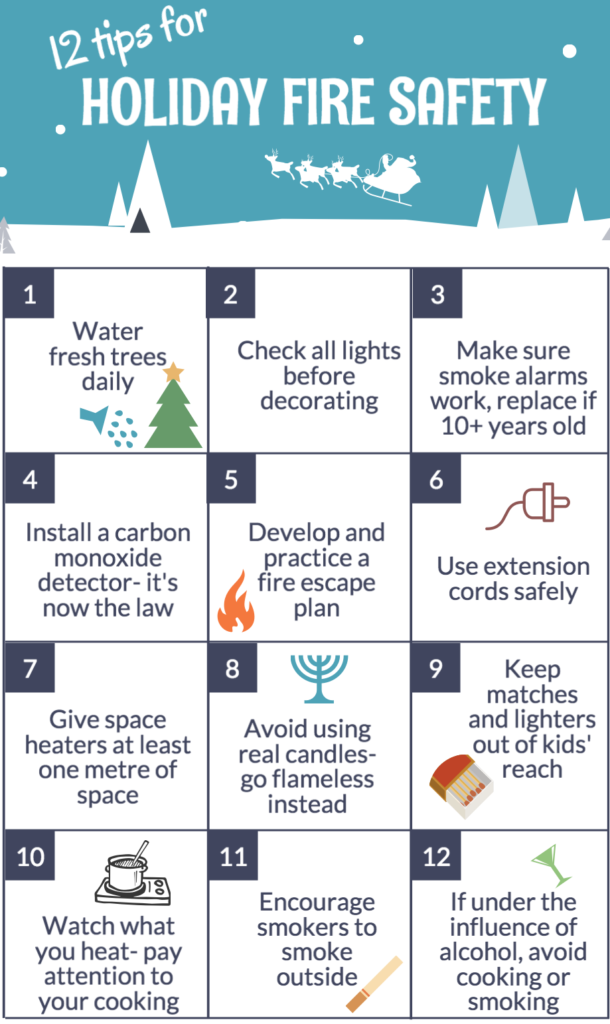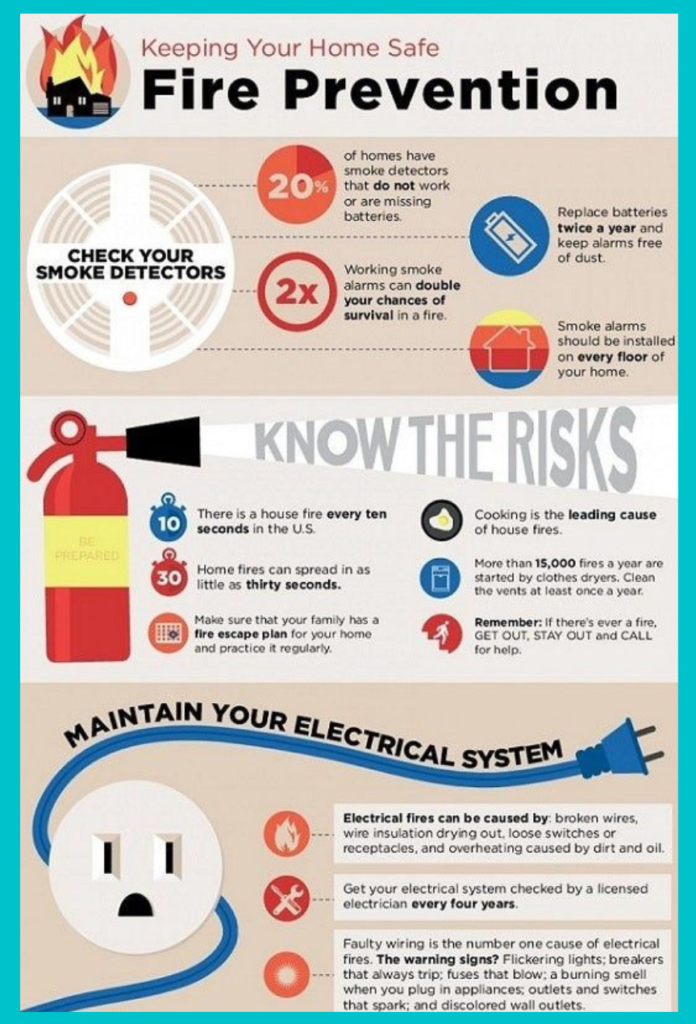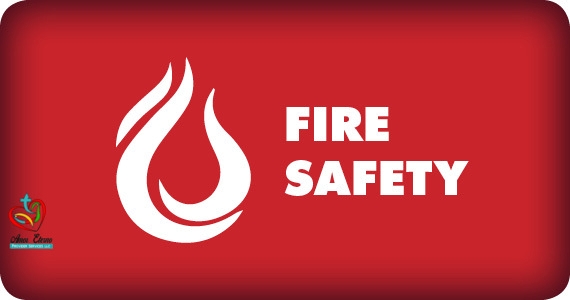Before a Fire
Create and Practice a Fire Escape Plan
Remember that every second counts in the event of a fire. Escape plans help you get out of your home quickly. Practice your home fire escape plan twice each year. Some tips to consider when preparing this plan include:
- Find two ways to get out of each room in the event the primary way is blocked by fire or smoke.
- Make sure that windows are not stuck, screens can be taken out quickly and that security bars can be properly opened.
- Practice feeling your way out of the house in the dark or with your eyes closed.
- Teach children not to hide from firefighters.
- If you use a walker or wheelchair, check all exits to be sure you can get through the doorways.
Fire Safety Tips
- Make digital copies of valuable documents and records like birth certificates.
- Sleep with your bedroom door closed.
- Keep a fire extinguisher in your kitchen. Contact your local fire department for assistance on proper use and maintenance.
- Consider installing an automatic fire sprinkler system in your residence.
During a Fire
- Drop down to the floor and crawl low, under any smoke to your exit. Heavy smoke and poisonous gases collect first along the ceiling.
- Before opening a door, feel the doorknob and door. If either is hot, or if there is smoke coming around the door, leave the door closed and use your second way out.
- If you open a door, open it slowly. Be ready to shut it quickly if heavy smoke or fire is present.
- If you can’t get to someone needing assistance, leave the home and call 9-1-1 or the fire department. Tell the emergency operator where the person is located.
- If pets are trapped inside your home, tell firefighters right away.
- If you can’t get out, close the door and cover vents and cracks around doors with cloth or tape to keep smoke out. Call 9-1-1 or your fire department. Say where you are and signal for help at the window with a light-colored cloth or a flashlight.
- If your clothes catch fire, stop, drop and roll – stop immediately, drop to the ground and cover your face with your hands. Roll over and over or back and forth until the fire is out. If you or someone else cannot stop, drop and roll, smother the flames with a blanket or towel. Use cool water to treat the burn immediately for three to five minutes. Cover with a clean, dry cloth. Get medical help right away by calling 9-1-1 or the fire department.
After a Fire
- Contact your local disaster relief service, such as The Red Cross, if you need temporary housing, food and medicines.
- Check with the fire department to make sure your residence is safe to enter.
- DO NOT attempt to reconnect utilities yourself. The fire department should make sure that utilities are either safe to use or are disconnected before they leave the site.
- Conduct an inventory of damaged property and items. Do not throw away any damaged goods until after you make the inventory of your items.
- Begin saving receipts for any money you spend related to fire loss. The receipts may be needed later by the insurance company and for verifying losses claimed on your income tax.
- Notify your mortgage company of the fire.
Prevent Christmas tree fire hazards
- Check that your live tree is fresh — nobody likes a burning Christmas tree! The needles should be hard to pull from the branches and don’t break when bent between your fingers. The bottom of the trunk should be sticky with resin. If you tap the tree on the ground, few needles should fall off.
- Keep the tree away from heat sources such as fireplaces, space heaters, candles, vents and radiators.
- Be sure to check the water level daily and make sure the stand is filled with water. Heated rooms will quickly dry out the tree.
- Practice Christmas tree safety by placing the tree out of traffic and make sure it’s not blocking doorways.
- If you buy an artificial tree, be sure to look for the “Fire Resistant” label. The label doesn’t guarantee the tree won’t catch on fire, but it does indicate the tree is more resistant to catching on fire.
- If you used a real tree, be sure to place it far from your home or other combustible objects when you’re finished with it. This is because as it ages and is removed from watering, it will dry out and become more flammable.
- Different areas have different rules for recycling trees. Check with your local government website and/or your garbage collector to see your pickup options. In some cases, this can include recycling real trees for mulch.
How to avoid candle fires
- Only burn candles where you can keep an eye on them.
- When you go to bed, leave the room or leave the house, extinguish all candles.
- Ensure candles are placed on heat resistant, stable surfaces and where kids and pets can’t reach them or knock them over.
- Candles should always be placed far away from items that could catch fire and burn easily, such as trees, decorations, curtains and furniture.
How do you avoid electrical fires?
- Practice Christmas light safety by buying your lights from reputable retailers. Check that your lights are approved by a nationally recognized testing lab such as UL, Intertek or CSA. UL identifies products meeting safety requirement for indoor and outdoor use with a red holographic label. For indoor only usage, the product will have a green holographic label.
- Be sure to check all lights and throw out any with sockets that are broken or cracked and wires that are frayed, bare or with loose connections.
- Never use electric lights on metallic trees.
- Make sure to use extension cords for their intended use — indoors, outdoors or both.
- Be sure to plug outdoor Christmas lights into circuits that are protected by Ground Fault Circuit Interrupters (GFCIs).
- Fasten outdoor lights securely to the house, trees or other supports to keep them from pulling away with the wind. But don’t damage the cord with fasteners. Take care not to puncture roofing shingles when fastening lights to the home.
- Watch for water and snow and keep both extension cords and lights clear of them.
- Make sure cords and light strands are not pinched in doors, windows or under furniture. This can damage the cord and its insulation.
- When you leave home or go to bed, be sure to turn off all indoor and outdoor Christmas lights and electrical decorations.
- Be very careful around power lines — keep yourself and your equipment at least 10 feet away from them.
- Don’t overload electrical outlets with too many decorations or other electrical devices — they could overheat and cause a fire.
Is your fireplace ready for the holidays?
- Before using the fireplace, it’s recommended to have it inspected annually to see if your chimney should be cleaned.
- Be sure to keep a screen on the fireplace to prevent embers from popping out and landing on the floor or carpet.
- Don’t burn wrapping paper in the fireplace. The paper ignites quickly and burns intensely and could result in a flash fire. Only use seasoned wood.
- Be careful with “fire salts” which produce colored flames when thrown on wood fires. If swallowed, they can cause vomiting. They also contain heavy metals that can cause gastrointestinal irritation.
Additional safety tips for decorating this holiday season
Fires are just one area of safety to think about during the holiday season. Decorating can also be something that can cause injuries.
- If there are small children in the home, take special care to avoid heavy, sharp or breakable decorations. And be sure children can’t reach decorations with small removable parts that can be swallowed or inhaled. Don’t tempt children with decorations that resemble candy or food that they might try to eat.
- Check ladders for loose or missing screws, hinges, bolts and nuts before you use them.
- When decorating outside, use wooden or fiberglass ladders. Metal ladders can conduct electricity.
- Ladders should extend at least three feet past the edge of the roof.




